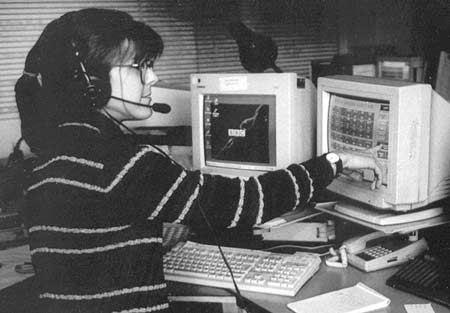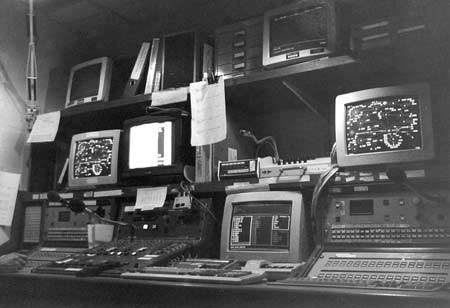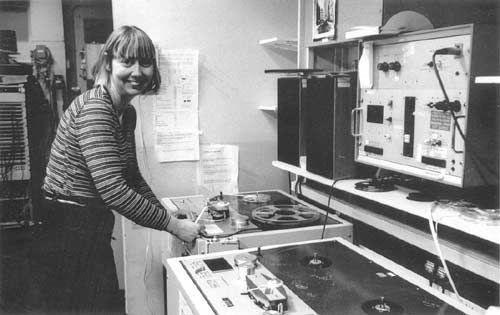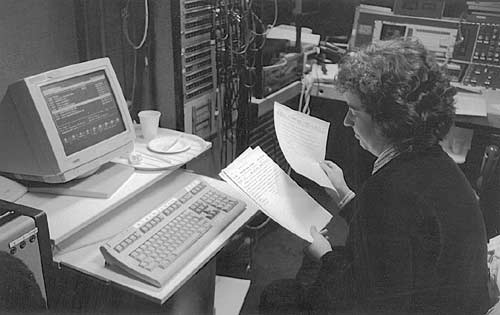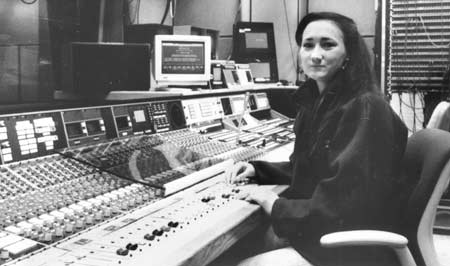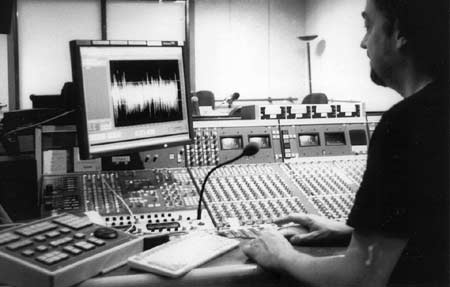In the 1990s Jonathan joined News and Current Affairs
Sound Operations. This had just been formed with SMs from the old Programme
Operations Group 1 together with operators from Control Room and OBs. The
group now had their own studios in BH and Bridge Street, and took over the
operation of Radio Cars and News Traffic.
Radio News Operations faced many changes in the 1990s. A new 'rolling' news
and sport network was unveiled, and our main recording medium, tape, was replaced
with computer technology.
News intake was still via the tried and tested 'News Traffic Unit' run by
Donna Eaton (who was later recognised in the New Year Honours list for services
to broadcast news). Traffic experienced a complete transformation. Up to this
time the area resembled an Edwardian telephone exchange: all
GPO plugs and cords and bakerlite! In the 1990s a brand new system came in,
designed and project-managed by the BBC's Trevor Smith.
The system was based around touch-screen technology. Traffic Managers could
select from several 'pages' on their terminals, to select sources, start and
stop tape recorders (in H30, Bush Newsroom and the Sound Recording Unit at
Television Centre). They could also set up conference calls between the correspondents
and the various programme editors and newsroom producers.
The engineering side of Traffic also changed. At that time it was called NTOC
(News Traffic Operations Centre), but evolved simply to NOC. We still had
the landline routers with their associated Telephone Balance Units for cue
programme, but slowly ISDN lines came in. By the end of the 90s all the copper-wire
inland circuits had been replaced with ISDN lines.
The 'hub' of newsgathering, as far as we SMs were concerned, still remained
in H30, and we saw through the whole of the first Gulf War (and the so-called
'Scud-FM' - a rolling service on R4 FM) using ¼ inch tape. However,
SMs were rapidly required to transfer their editing skills from tape to computer.
No longer would SMs be the sole craft-skilled editors: with the advent of
D-CART newsroom editorial staff were required to acquire skills as 'desk-top'
editors. Needless to say, some found the transfer of skills difficult, and
tape did live on in a limited form for some time.
The D-CART system was developed by ABC Australia, and it allowed recording,
editing and playback of audio stored centrally. Traffic would record dispatches
directly into the system. Then, anyone with access to a terminal could edit
the material, non-destructively. Different versions of the same item could
be prepared, perhaps a short version for a Radio 2 summary and a longer one
for a Radio 4 bulletin. It was possible to assemble material from several
different recordings, though the lack of level control meant that packages
assembled this way could contain significant variations of level. One danger
was that the system could run out of storage space, so studio 3G became 'D-CART
control' and was

required to keep an eye on the remaining record time available, then make
sweeping decisions on what to delete to free-up space. Indeed 3G was very
busy at this time: it did the Radio 2 summaries on the hour, Radio1 (Newsbeat)
summaries on the half-hour, and recording and mixing reporters' pieces for
bulletins and summaries in between. Later, Radio 5 Live summaries would come
from 3G, when Radio 2 transmissions were self-operated by the announcer in
studio 3F, next door.
D-CART was installed in all the news studios, with Sony Minidisc as a backup.
Studios were provided with two playback channels and these were left plugged
to channels on the GP desks, just like a couple of tape machines. News bulletins
would be made up into a 'playlist' to allow sequential playback of inserts
in order; it could become a bit tricky if the editor wanted to change the
order or if the newsreader got out of sequence!
Even the venerable Today programme, seen here in Studio 4A, had to accept
the switch to D-CART, and this led to a reduction in manning from 3 to 2 SMs.
The department gained a new suite of studios for the new Radio 5 Live service.
Studios 1A and 1B, with the SSL mixers, were the main TX studios, and the
network flip-flopped between the two throughout the day. R5 is a 'direct to
TX' network, with no continuity studio to switch between sources, so SMs became
used to switching the network on the Drake router system.
By the end of the decade the decision had been made to move the entire news
operation (except Radio 1) to TV Centre in west London. New off-the-shelf
desks were brought in, and, after some time, sweeping modifications were demanded
by SMs. Even D-CART came to the end of its life and was replaced with VCS Dira
and BNCS routers.
